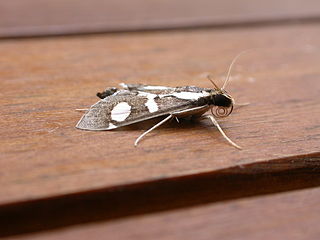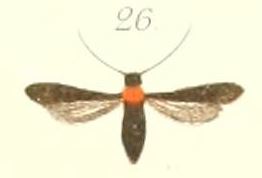
A bicolor cat or black-and-white cat is a cat with white fur combined with fur of some other color, for example solid black, tabby, or colorpointed. There are various patterns of bicolor cat. These range from the Van-patterned through to solid color with a throat locket or medallion. Bicolor coats are found in many cat breeds, as well as being common in domestic longhair and domestic shorthair cats.

Theobroma is a genus of flowering plants in the mallow family, Malvaceae, that is sometimes classified as a member of Sterculiaceae. It contains roughly 20 species of small understory trees native to the tropical forests of Central and South America.

Sorghum bicolor, commonly called sorghum and also known as great millet, broomcorn, guinea corn, durra, imphee, jowar, or milo, is a grass species cultivated for its grain, which is used for food for humans, animal feed, and ethanol production. Sorghum originated in Africa, and is now cultivated widely in tropical and subtropical regions. Sorghum is the world's fifth-most important cereal crop after rice, wheat, maize, and barley, with 61,000,000 metric tons of annual global production in 2021. S. bicolor is typically an annual, but some cultivars are perennial. It grows in clumps that may reach over 4 metres (13 ft) high. The grain is small, ranging from 2 to 4 millimetres in diameter. Sweet sorghums are sorghum cultivars that are primarily grown for forage, syrup production, and ethanol; they are taller than those grown for grain.
Eurosia is a genus of moths in the family Erebidae. The genus was erected by George Hampson in 1900.

Lophocampa is a genus of moths in the family Erebidae. The genus was erected by Thaddeus William Harris in 1841. It contains around 75 species.

Lycomorphodes is a genus of moths in the family Erebidae.

Syssphinx bicolor, the honey locust moth, is a North American moth in the family Saturniidae.
Stigmella bicolor is a moth of the family Nepticulidae. It is found in Kazakhstan, Uzbekistan, Tajikistan and Kyrgyzstan.
Conopsia lambornella is a moth of the family Sesiidae. It is known from Nigeria.
Conopsia terminiflava is a moth of the family Sesiidae. It is known from Cameroon.

Glyphodes bicolor is a species of moth of the family Crambidae described by William John Swainson in 1821. It is widely distributed in the Old World tropics, including South Africa, China, Thailand, India, New Guinea and Australia.

Manulea bicolor, the bicolored moth or yellow-edged footman, is a moth of the family Erebidae. It is found in boreal North America, from Labrador and Massachusetts to Yukon and British Columbia. In the Rocky Mountains, it ranges south to southern Colorado. The habitat consists of boreal forests, parklands and riparian cottonwoods in the prairies.

Gonometa bicolor is a moth of the family Lasiocampidae. It is known from Angola.
Sesamia cretica, the corn stem borer, greater sugarcane borer, sorghum stem borer, stem corn borer, durra stem borer, large corn borer, pink sugarcane borer, sugarcane pink borer, sorghum borer, pink corn borer, maize borer or purple stem borer, is a moth of the family Noctuidae. It was described by Julius Lederer in 1857. It is found in most of the countries and islands of the Mediterranean basin. The range extends through the Middle East and Arabia to Pakistan, northern India and northern Africa. In the south, the range extends to northern Kenya and northern Cameroon.

Epinotia bicolor is a species of moth of the family Tortricidae. It is found in China, Taiwan, Korea, Japan, Vietnam and India.
Rhopobota bicolor is a species of moth of the family Tortricidae. It is found in China, Taiwan, Japan and Thailand.
Tortrix sinapina, the Japanese oak leafroller, is a species of moth of the family Tortricidae. It is found in the Russian Far East (Ussuri), China (Zhejiang) and Japan.

Phoenicophanta bicolor is a species of moth in the family Noctuidae. It was first described by William Barnes and James Halliday McDunnough in 1916 and it is found in North America.

Parasa bicolor, the green rice moth, is a moth of the family Limacodidae. The species was first described by Francis Walker in 1855. It is found in Sri Lanka, India, Nepal, Pakistan, Myanmar, Laos, Taiwan, Vietnam, Malaysia, Java, China and Taiwan.

The Tinthiinae are a subfamily of clearwing moths, first established in 1917 by Ferdinand Le Cerf.











